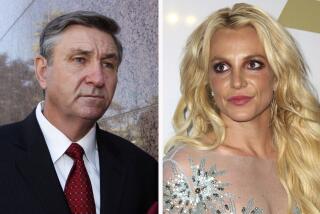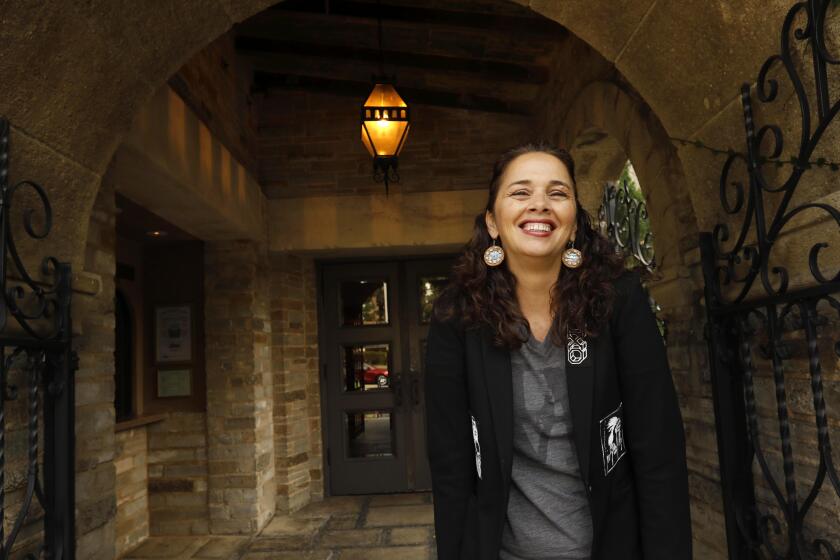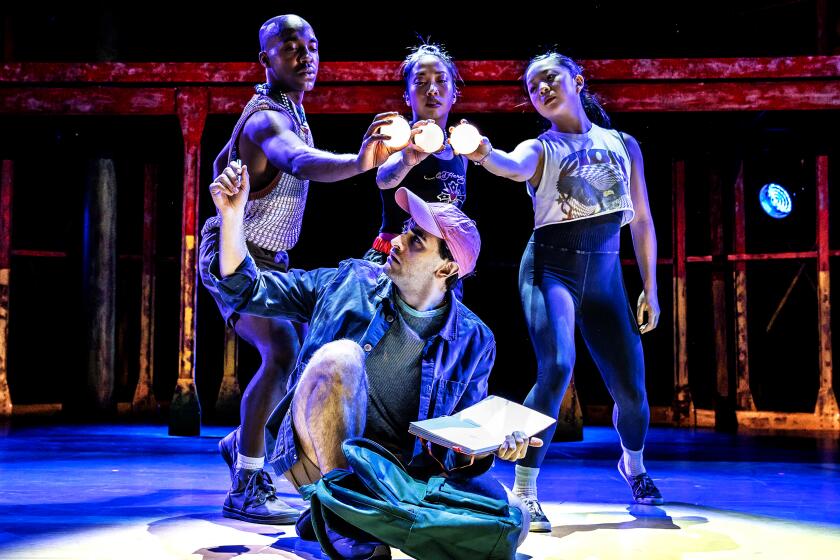Peter. Wendy. Lenny?
Albert Ihde and Ellen Pasternack’s nuptials involved much more than the union of two souls -- there was also the ritual joining together of their record collections, which ran a close second for the founding couple behind Santa Barbara Theatre. And when Pasternack first heard Ihde’s original recording of Leonard Bernstein’s little-known score for “Peter Pan,” which debuted on Broadway in 1950, she was gobsmacked.
“I said to him, ‘This is a lost masterpiece,’ ” Pasternack recalls of that moment in summer 2004. “ ‘Where has this been?’ ”
In a rehearsal room behind her, half a dozen scruffy actors are practicing the steps of the pirate dance from the show’s first American revival of note, which opens Friday at the Lobero Theatre in Santa Barbara. (Bernstein’s “Peter Pan” has resurfaced only sporadically since, including a production by a Midwest theater company 20 years ago, but even the composer’s estate is fuzzy on the details.) The production comes amid a flurry of activity worldwide celebrating the 90th anniversary of the composer’s birth, but the timing is serendipitous -- “Peter Pan’s” return is the culmination of events stretching back more than half a century.
Technically not considered a musical but rather a play with music, Bernstein’s version of the J.M. Barrie classic opened on April 24, 1950, with then-49-year-old Jean Arthur in the title role and Boris Karloff as Capt. Hook. Critics such as Brooks Atkinson embraced the production; the New York Times theater maven called it “a melodic, colorful and dramatic score that is not afraid to be simple in spirit.”
Simple for Bernstein, that is. The remarkably versatile composer infused the score with a rich blend of influences -- sharp listeners will notice allegro snippets from Bach’s “Brandenburg” Concerto No. 3 -- and complex rhythms and harmonies, which foreshadowed some of his later works, including “Candide,” “West Side Story” and “Chichester Psalms.”
“My guess would be that Bernstein had a lot of fun with this show,” says Garth Edwin Sutherland, music editor of the Leonard Bernstein Office, which holds the rights to his works. “His music tends to be very complicated, although we don’t think of it that way. Peter Pan is the ur figure of innocence -- the boy who won’t grow up -- and the music has a similar quality of childishness in the best possible sense that you don’t see that much in his other works, not unsophisticated but innocent and straightforward.”
Still, after a 10-month run and a brief national tour, the show closed and vanished off the cultural map. It may seem strange that in the Information Age, where it seems that little is left unexamined, an obscure work by such an important composer should even exist, ripe for rediscovery more than half a century after its debut.
Did he or didn’t he?
Complicating matters further was the Columbia recording, made in June 1950, which included five of the eight songs Bernstein wrote for the show but substituted an underscore (music under spoken words) by Alec Wilder, a composer of jazz, opera and popular music. That has led to the rise of what is known on LeonardBernstein.com’s chat board as “The Peter Pan Question”: Did he or didn’t he write the complete score that was performed on Broadway?
According to the composer’s New York-based estate, he did indeed. “There’s a frustrating misconception that because [Wilder’s] music appeared on the recording that it appeared on Broadway, and that wasn’t the case,” Sutherland says. The recording was designed as a children’s storytelling LP rather than a conventional original cast album, and Sutherland speculates that Bernstein’s complex underscore was replaced because Wilder’s simpler, more child-friendly music was more in tune with the added narration.
In 1953, the Walt Disney Co.’s hit animated film of “Peter Pan” entered theaters around the country as well as the popular consciousness. “And suddenly people thought, that’s what ‘Peter Pan’ was -- a Disney cartoon,” Ihde says.
Perhaps more damaging for the show’s prospects, another production of “Peter Pan,” starring Mary Martin, opened on Broadway in 1954; it was directed and choreographed by Jerome Robbins, with songs by Mark Charlap and Carolyn Leigh and additional numbers by Jule Styne and the team of Betty Comden and Adolph Green. That “Peter Pan” was a full-fledged musical with 18 songs, far more than Bernstein’s version, which had originated as a vehicle for Arthur, a retired film actress not known for her singing.
The producers had commissioned Bernstein to write only incidental music, but, according to his biographer, Humphrey Burton, the composer-lyricist surprised them with eight songs as well (although a few were dropped from the Broadway production in part because the stars weren’t strong enough vocalists to perform them).
The Mary Martin musical opened to mixed reviews and had a limited run of 152 performances -- less than half the number logged by the Bernstein production. But the reason the show closed was because NBC had bought the broadcast rights; when “Peter Pan” aired in 1955, it drew the largest audience for a single TV show. The broadcast later became a holiday staple, etched in the minds of baby boomers as the definitive production.
And for small theaters, producing the musically accessible Charlap-Styne version simply made more sense. “If you’re going to do a musical, that’s the one you’ll do,” Sutherland says. “Bernstein’s version isn’t really a musical, but it needs the resources of a musical.”
For years, “Peter Pan” stayed buried in plain sight, listed under “Theater Works,” that could be licensed for performance. In 1997, Alexander Frey, then the Rome Philharmonic Orchestra’s U.S.-born principal conductor, came across a song, “Dream With Me,” which had been cut from the original Broadway production.
“If there was one song cut from the original production, might there be more music existing that may have met a similar fate?” Frey wrote in the liner notes for the 2005 recording he conducted for Koch International Classics after years searching for the answer. (He’s also conducting the Santa Barbara production at his request.)
That recording, with Linda Eder singing the role of Wendy and Daniel Narducci as Hook, was based on copies of the score used in the 1988 Midwestern production, which Frey had obtained from the estate. That version included Bernstein’s instrumental music -- not Wilder’s -- but the score had still been through numerous hands, both on Broadway and thereafter. Frey’s recording spurred the estate to investigate the composer’s original intent. Sutherland retrieved Bernstein’s original materials from the Library of Congress in 2006; he spent nine months eliminating changes made by others during the development of the Broadway production when Bernstein was working in Europe. He also added 23 musical cues in the composer’s language to accommodate the action on stage.
“We made a big investment in the new score -- a usable version that theaters can rent and use in a way that’s not going to make them cry the way the older materials would have,” Sutherland says. “You don’t want the orchestra to sit there for 20 minutes earning their wage but not playing.”
Gaining the rights
Frey’s recording also inspired Santa Barbara Theatre to produce the show, and its production has evolved into the world premiere of the new, definitive score. But Ihde and Pasternack first had to vault a stumbling block: Samuel French, which controlled the U.S. performance rights to both the Barrie play and the Charlap-Styne musical, initially balked at allowing them to produce the play with the Bernstein music, saying it would conflict with the better-known version it managed. The organization later relented after the King’s Head Theatre, a London company that staged the show in 2006, put them in touch with Barrie’s estate and London’s Great Ormond Street Hospital for children, which control the rights in the U.K., and both lent their support.
Ihde says the Bernstein “Peter Pan” hews more closely to Barrie’s novel, which focuses more on Wendy, the oldest Darling child, whom Peter spirits away to Never Land. Four of the eight songs were written for her. “Bernstein was able to capture Barrie’s idea, which he explained in the novel, that this is Wendy’s story about this character she meets, and just as she is about to grow up, she has decisions to make about who she is.”
Hook gets a lush, operatic solo in “Hook’s Soliloquy” -- cut from the Broadway production because Karloff couldn’t sing it. In Santa Barbara, the honor goes to Robert Yacko, a veteran of “Fiddler on the Roof” on Broadway and regional productions of Stephen Sondheim. He appears with Sarah Bierstock, who studied with Marni Nixon and plays Wendy, and Corina Boettger, 18, who will fly across the stage as Peter.
A few weeks ago, the company met its $400,000 fundraising goal with the help of local cultural philanthropists such as developer and banker Michael Towbes, who anticipate that annual holiday productions will be a boon to the city’s economic health.
For Santa Barbara Theatre’s producing director, the appeal is much more personal. Ihde says that seeing the show on Broadway was a life-altering experience.
“I was 5, and I knew right then that I wanted to do theater and film, no question,” he says. “My mother thought I wanted to be Peter Pan. ‘No, it’s the set, it’s the lighting, it’s the flying, it’s the whole thing.’ I find the play more compelling than the musical. Bernstein’s music, I’ve always been in love with his stuff. And this was Bernstein at the peak of his form.”
--
--
‘Peter Pan’
Where: Lobero Theatre, 33 E. Canon Perdido St., Santa Barbara
When: Opens Friday. Go to www.SBTheatre.org for schedule. Ends Dec. 28.
Price: $45 to $70
Contact: (805) 963-0761
More to Read
The biggest entertainment stories
Get our big stories about Hollywood, film, television, music, arts, culture and more right in your inbox as soon as they publish.
You may occasionally receive promotional content from the Los Angeles Times.





